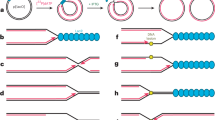Abstract
Mammalian cells require a cyclin D-dependent kinase for the cell cycle start, yet many mesenchymal cells express three seemingly redundant D cyclins and similarly, seemingly redundant Cdk4 and Cdk6 as their kinase partners. We have found that the Cdk6-cyclin D3 complex is unique among the D cyclin and kinase combinations in the ability to promote the cell cycle start. In an anchorage-minus G1-arrested rat fibroblast, only Cdk6-D3 retains kinase activity due mainly to its ability to evade inhibition by p27KIP1 and p21CIP1 with a resemblance to viral cyclin-bound Cdk6. Rodent fibroblasts engineered to overexpress both Cdk6 and cyclin D3 highly resist serum starvation- or cell–cell contact-imposed G1-arrest. In BALB/c 3T3 cells, D3 is constitutively expressed, but Cdk6 is markedly induced with concomitant activation upon stimulation with a growth-promoting factor. These results suggest a role for the Cdk6-D3 complex in regulating cell's proliferation ability in response to external stimuli.
This is a preview of subscription content, access via your institution
Access options
Subscribe to this journal
Receive 50 print issues and online access
$259.00 per year
only $5.18 per issue
Buy this article
- Purchase on Springer Link
- Instant access to full article PDF
Prices may be subject to local taxes which are calculated during checkout







Similar content being viewed by others
References
Belyavskyi M, Braunagel SC, Summers MD . 1998 Proc. Natl. Acad. Sci. USA 95: 11205–11210
Chang Y, Moore PS, Talbot SJ, Boshoff CH, Zarkowska T, Godden-Kent D, Paterson H, Weiss RA, Mittnacht S . 1996 Nature 382: 410
Cheng M, Olivier P, Diehl JA, Fero M, Roussel M, Roberts JM, Sherry CJ . 1999 EMBO J. 18: 1571–1583
Chilosi M, Doglioni C, Yan Z, Lestani M, Menestrina E, Sorio C, Beneditti A, Vinante E, Pizzolo G, Inghirami G . 1998 Am. J. Pathol. 152: 209–217
Dong F, Agrawal D, Bagui T, Pledger WJ . 1998a Mol. Biol. Cell. 9: 2081–2092
Dong F, Cress Jr WD, Agrawal S, Pledger WJ . 1998b J. Biol. Chem. 273: 6190–6195
Dyson N . 1998 Genes Dev. 12: 2245–2262
Herzinger T, Reed SI . 1998 J. Biol. Chem. 273: 14958–14961
Hunter T, Pines J . 1994 Cell 79: 573–582
Jinno S, Hung SC, Okayama H . 1999a Oncogene 18: 565–571
Jinno S, Hung SC, Yamamoto K, Lin J, Nagata A, Okayama H . 1999b Proc. Natl. Acad. Sci. USA 96: 13197–13132
Kitagawa M, Higashi H, Jung H-K, Suzuki-Takahashi I, Ikeda M, Tamai K, Kata J, Segawa K, Yoshida E, Nishimura S, Taya Y . 1996 EMBO J. 15: 7060–7069
Kume K, Jinno S, Miwatani H, Kizaka-Kondoh S, Terada Y, Nojima H, Okayama H . 1992 New Biol. 4: 504–511
LaBaer J, Garrett MD, Stevenson LF, Slingerland JM, Sandhu C, Chou HS, Fattaey A, Harlow E . 1997 Genes Dev. 11: 847–862
Mizushima S, Nagata S . 1990 Nuc. Acids Res. 18: 5322
Nakanishi M, Robetorye RS, Adami GR, Pereira-Smith OM, Smith JR . 1996 EMBO J. 14: 555–563
Okayama H, Nagata A, Jinno S, Murakami H, Tanaka K, Nakashima N . 1996 Adv. Cancer Res. 69: 17–62
Orend G, Hunter T, Ruoslahti E . 1998 Oncogene 16: 2575–2583
Schulze-Gahmen U, Jung JU, Kim SH . 1999 Structure Fold Des. 7: 245–254
Sherr CJ, Roberts JM . 1999 Genes Dev. 13: 1501–1512
Slingerland JM, Hengst L, Pan C-H, Alexander D, Stampfer MR, Reed SI . 1994 Mol. Cell. Biol. 14: 3683–3694
Swanton C, Mann DJ, Fleckenstein B, Neipel F, Peters G, Jones N . 1997 Nature 390: 184–187
Tatsuka M, Mitsui H, Wada M, Nagata A, Nojima H, Okayama H . 1992 Nature 359: 333–336
Terada Y, Tatsuka M, Jinno S, Okayama H . 1995 Nature 376: 358–362
Tiefenbrun N, Melamed D, Levy N, Resnitzky D, Hoffman I, Reed SI, Kimchi A . 1996 Mol. Cell. Biol. 16: 3934–3944
Van Dyk LF, Hess JL, Katz JD, Jacoby M, Speck SH, Virgin IV HW . 1999 J. Virol. 73: 5110–5122
Wagner EF, Hleb M, Hanna N, Sharma S . 1998 J. Immunol. 161: 1123–1131
Acknowledgements
We thank J Kato for the mouse cyclin D3 cDNA and M Nakanish for GST-fused p27KIP1. This work was supported by grants from the Ministry of Education and Culture, Japan.
Author information
Authors and Affiliations
Rights and permissions
About this article
Cite this article
Lin, J., Jinno, S. & Okayama, H. Cdk6-cyclin D3 complex evades inhibition by inhibitor proteins and uniquely controls cell's proliferation competence. Oncogene 20, 2000–2009 (2001). https://doi.org/10.1038/sj.onc.1204375
Received:
Revised:
Accepted:
Issue Date:
DOI: https://doi.org/10.1038/sj.onc.1204375
Keywords
This article is cited by
-
Molecular mechanism of G1 arrest and cellular senescence induced by LEE011, a novel CDK4/CDK6 inhibitor, in leukemia cells
Cancer Cell International (2017)
-
Hepatitis B virus X protein-mediated non-coding RNA aberrations in the development of human hepatocellular carcinoma
Experimental & Molecular Medicine (2017)
-
The alpha-fetoprotein (AFP) third domain: a search for AFP interaction sites of cell cycle proteins
Tumor Biology (2016)
-
Loss of TACSTD2 contributed to squamous cell carcinoma progression through attenuating TAp63-dependent apoptosis
Cell Death & Disease (2014)
-
Part II—mechanism of adaptation: A549 cells adapt to high concentration of nitric oxide through bypass of cell cycle checkpoints
Tumor Biology (2014)



